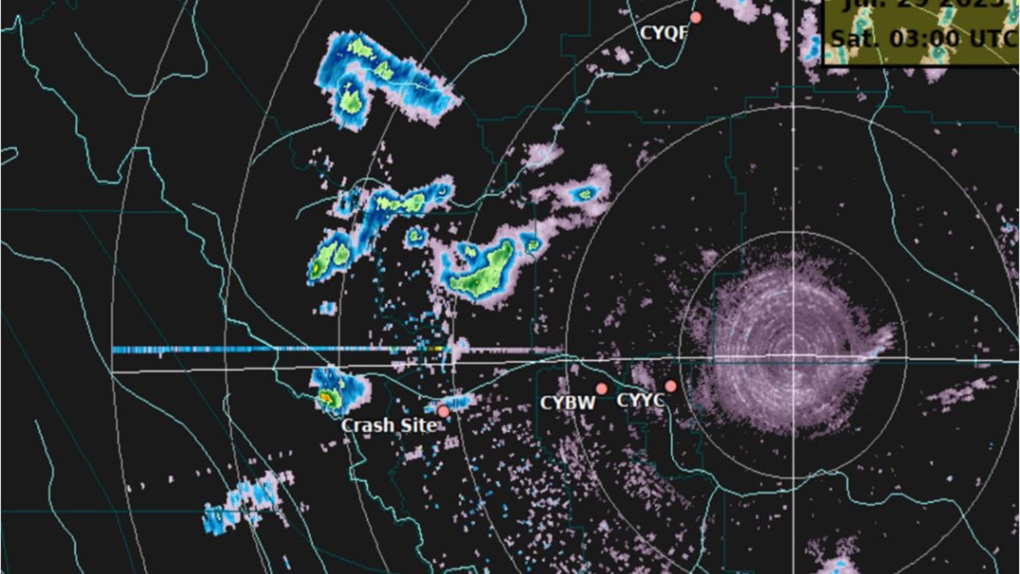Pilot error to blame for Calgary plane crash that killed 6: report
 Layout of aircraft wreckage at the TSB regional office in Edmonton. (Source: TSB)
Layout of aircraft wreckage at the TSB regional office in Edmonton. (Source: TSB)
A formal investigation into a fatal plane crash west of Calgary that killed six people in 2023 says the pilot was ill prepared and was driven by "personal desire" to make the flight.
The Transportation Safety Board of Canada (TSB) released its report into the crash of the private aircraft on Wednesday.
The investigation says the Piper PA-32R aircraft took off from the Springbank Airport on July 28, 2023, on "a visual flight rules flight" to Salmon Arm, B.C.
Approximately 15 minutes after takeoff, the plane crashed into Mount McGillivray and killed everyone on board.
- Sign up for breaking news alerts from CTV News, right at your fingertips
- The information you need to know, sent directly to you: Download the CTV News App
In its report, the TSB said one of the errors the pilot made was not obtaining a Nav Canada weather briefing before the flight and instead relying on "sources on the Internet."
"Person-to-person weather briefings are provided by Nav Canada flight information centres free of charge," the report said.
"Regional specialists provide interpretive weather briefings, advisory services and flight plan filing by telephone."
The report went on to say that the cloud ceiling in the Exshaw area, where the crash occurred, were lower than what was reported further east.
"Local highway cameras close to the crash location showed obscured mountain tops in the region as well, which further suggests that mountain peaks near the crash site were well obscured by low level clouds," the TSB said, quoting an excerpt from an independent report from Enivronment and Climate Change Canada.
 Weather radar image of the area of the occurrence at 2100 (Source: Environment and Climate Change Canada, Meteorological Service of Canada, Prediction Services Directorate, Meteorological Assessment July 28, 2023, Kananaskis Village, Alberta (08 November 2023), p. 18)
Weather radar image of the area of the occurrence at 2100 (Source: Environment and Climate Change Canada, Meteorological Service of Canada, Prediction Services Directorate, Meteorological Assessment July 28, 2023, Kananaskis Village, Alberta (08 November 2023), p. 18)
An analysis of the wreckage and impact marks on the rock face "were consistent with the aircraft being in a cruise altitude," the report said.
In addition to the inattention to weather, the TSB report said the pilot had several errors in decision making prior to the flight.
"Multiple factors, such as the desire to attend the social event in Salmon Arm, the diminishing available daylight and his familiarity with the (visual flight rules) route from (Springbank Airport), could have influenced the occurrence pilot's (decision making) and risk perception."
Since the pilot had flown the route before during the daytime, the TSB suggested "he likely considered that his previous experience and recent qualification justified his decision to conduct the approximately 1.7-hour flight."
However, as the flight was delayed due to inclement weather, the TSB said the pilot was monitoring the weather from an unknown data source and may have believed the weather was improving.
"The pilot likely had a lowered comprehension and perception of potential hazards along the route, resulting in an unanticipated encounter with instrument meteorological conditions, for which he was unprepared," the TSB said.
"The pilot's decision to depart was influenced by an incomplete understanding of the weather, familiarity with the route, time pressure, and a personal desire to complete the flight.
"When the pilot encountered clouds and reduced visibility, for unknown reasons, he decided to continue the flight toward the destination and, subsequently, the aircraft collided with terrain in the cruise attitude."
CTVNews.ca Top Stories

Should Canada be America's 51st state? Trump was 'teasing us,' says minister
Prime Minister Justin Trudeau will meet with all opposition leaders today before question period to brief them about his meeting with U.S. president-elect Donald Trump.
Canada Post removes deadline for Santa letter program amid strike
Canada Post says it has removed the deadline for its Santa Claus letter program amid an ongoing national workers' strike that has halted mail delivery leading up to the holiday season.
Young Manitoba woman dies after medical emergency during dental appointment
The Manitoba Dental Association (MDA) said it is investigating a critical incident where a young woman from the Morden-Winkler area died following a dental appointment.
South Korean parliament votes to defy president by lifting his declaration of martial law
South Korean President Yoon Suk Yeol declared martial law late Tuesday, vowing to eliminate 'anti-state' forces as he struggles against an opposition that controls the country's parliament and that he accuses of sympathizing with communist North Korea.
Jewish pro-Palestinian protesters occupy Ottawa parliament building
A group of Jewish-Canadian activists protesting Israel's ongoing armed offensive in Gaza have occupied a parliamentary building in Ottawa on Tuesday morning.
Toronto library apologizes after staff at east-end branch refuse to help lost girl
The Toronto Public Library is apologizing after staff at a branch in the city’s east end refused to provide a lost child with access to a telephone.
2 Ontario men charged after police seize US$40M in suspected cocaine from tractor-trailer in Illinois
Two Ontario men are facing charges after police in the U.S. say they seized 540 kilograms of cocaine from a tractor-trailer along Interstate 80 in Illinois.
Quebec prisons on lockdown after correctional officer severely beaten
Quebec prisons were in lockdown on Tuesday after a correction officer at the Sorel-Tracy detention centre was attacked this week.
This salad brand is being recalled again. Here's why
A Taylor Farms salad kit is being recalled over concerns of a salmonella contamination, according to the Canadian Food Inspection Agency.

































